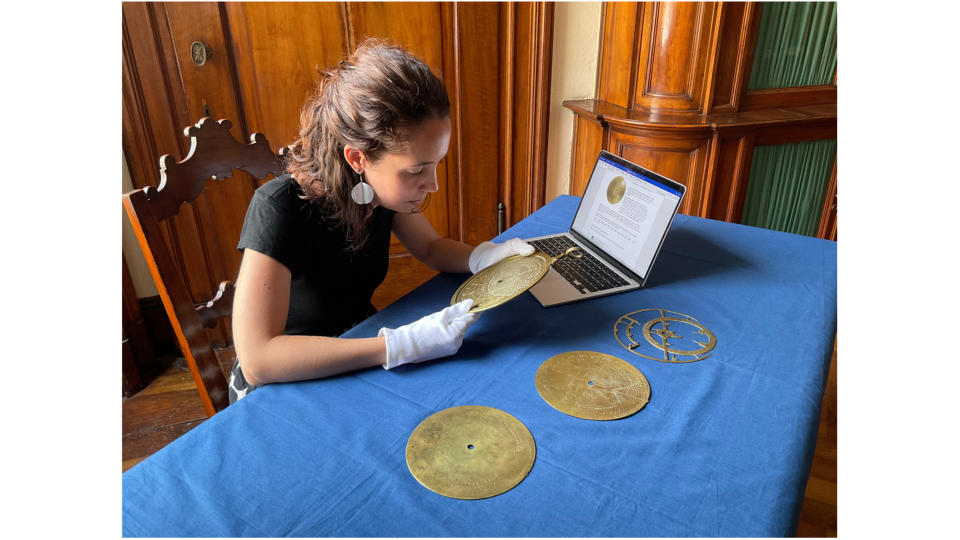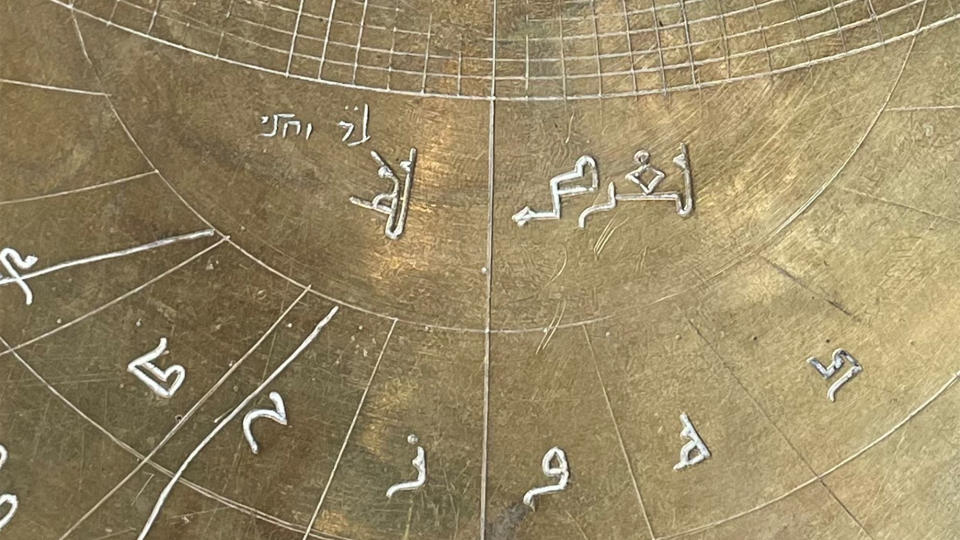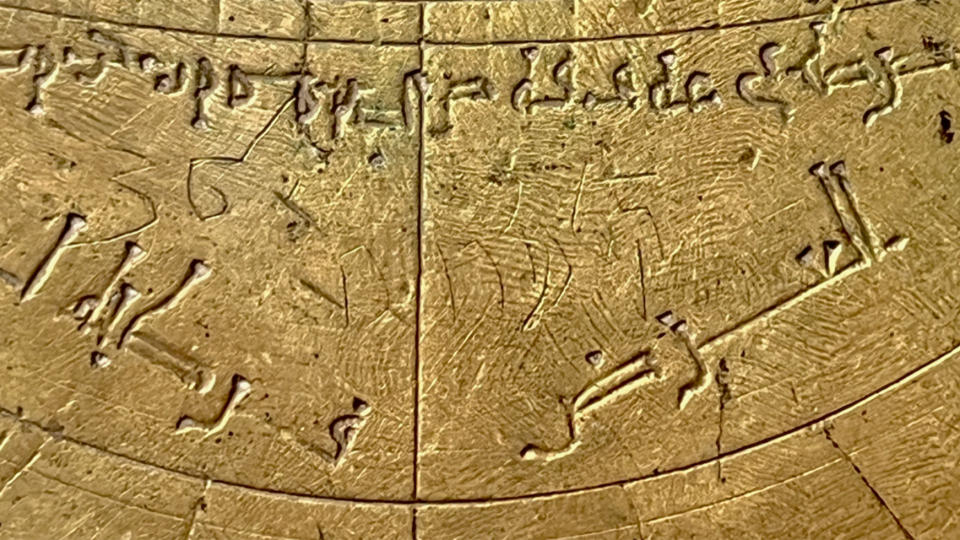An 11th century astrolabe – a device used to accurately calculate the date and time based on star positions – found in a museum in Verona, Italy, is clear evidence of scientific exchange and cooperation between Muslims, Jews and Christians, according to a new study.
The astrolabe is notable because, built by Muslim craftsmen, it then passed through the hands of Jewish and Christian users, who translated and adapted the portable device over the centuries. Such a widely shared astrolabe from almost a thousand years ago is an extremely rare find.
The bronze astrolabe languished in the archives of the Fondazione Museo Miniscalchi-Erizzo in Verona for decades, its true value unrealized, until the museum’s curator, Giovanna Residori, became curious and attracted the attention of Federica Gigante, a historian at the University of Cambridge who specializes in material and intellectual exchanges between Muslim people and Europe.
Related: What did ancient people know about astronomy?

“The current curator thought it was an intriguing object and wanted to know more about it,” says Gigante Space.com. “I just happened to see it on the museum’s website, so it was a happy coincidence.”
While inspecting the astrolabe, Gigante was amazed to discover how complex the history of this particular device was.
Astrolabes were invented by the ancient Greeks, but no astrolabes remain from that time. The earliest examples date previously from the late 8th century and were built by Arab astronomerswho at the time led the world in their scientific skills.
Astrolabes are constructed from a disk, around the edge of which the time or degrees of angular distance are marked. Attached to this disk are one or more circular plates, each plate for a specific latitude, and on top of that is another plate called a rete (pronounced “ree-tee”), on which is a map showing the brightest areas. stars in the air. The idea is to rotate the rete so that the position of the stars matches what is in the sky, and then use the hour scale around the edge to determine the time.
Astrolabes were designed by Islamic craftsmen specifically with religious use in mind.
“Every mosque would have had one,” Gigante said. “That makes perfect sense because the main function of an astrolabe is to tell the time, and that is one thing a muezzin does from a minaret, which is to sing the hour of prayer.”


There are a dozen examples of astrolabes of Arabic construction in museum collections around the world, but what makes the Verona astrolabe so striking is that it also contains inscriptions in Hebrew and in a Western language used in Christian countries at the time, in this case probably Italy.
Gigante says the astrolabe was probably built in Spain in the late 11th century. But she doesn’t know exactly when. “The star positions are not accurate enough for me to date them from that,” she said.
Soil wobbles around its axis, a so-called movement precession where the position of the stars relative to the north pole changes in a cycle that lasts 26,000 years. In the thousand years since the astrolabe’s construction, the stars have shifted about 14 degrees from a fixed background. But Gigante discovered that trying to rotate the sky back to match the positions on the astrolabe to determine when the astrolabe was made did not work, because the star positions on the astrolabe are not as accurate as modern measurements.
Instead, Gigante searched old tables of star coordinates from which astrolabes from this era were said to have been derived. She focused on those from Al-Andalus, a Muslim-ruled area of what is now Spain. Both Muslims and Jews lived side by side in Al-Andalus, and they all spoke Arabic. The Verona astrolabe has an inscription in Arabic that reads ‘for Isḥāq […]/the work of Yūnus.” In English those names are Isaac and Jonah, and they are likely Jewish nicknames written in Arabic – hence Gigante’s focus on Al-Andalus.


“If we think about what Spain was like in the 11th century, there were many different observatories where attempts were made to draw up maps of star coordinates and planet positions, and these were working groups of scientists always consisting of Jews and Muslims working side by side. different,” says Gigante.
Although she could not identify a specific table of star coordinates that informed Verona’s astrolabe, she did find one from Al-Andalus in 1068 that was close. This is supported by more inscriptions on one of the reversible plates, stating that they are for the latitudes of Cordoba and Toledo, both cities in the region.
At some point, however, the astrolabe appears to have changed hands. A second plate was added with an Arabic inscription saying it was intended for use in North Africa, somewhere in present-day Egypt or Morocco.
Related: The Mariner’s Astrolabe from the 1503 shipwreck is the oldest in the world
After this, the astrolabe received further adjustments. Arabic markings were crossed out and translated into Hebrew, the language of Jewish people in the rest of the world. Then, faint numbers written in a Western language were also scratched onto the disk, before the astrolabe eventually ended up in the hands of Ludovico Moscardo, a 17th-century nobleman in Verona. It became part of the collection of his Moscardo Museum, which was incorporated into the Fondazione Museo Miniscalchi-Erizzo in 1964, before finally coming to Gigante’s attention.
Astrolabes were the smartphones of their time. “Any educated person, especially those involved in astronomical or astrological matters, would have had one,” Gigante said.
Half of these users, like the muezzins in their minarets, are said to have used them to make astronomical measurements for religious regions. She would have used the other half for astrological purposes. In the 11th century, when our understanding of the heavens was limited, astronomy was and astrology were considered the same.
RELATED STORIES:
—Stonehenge’s orientation to the summer solstice can be seen in astonishing photographs in monuments across Britain
– Strange anomaly in the sun’s solar cycle discovered in ancient texts from Korea
– Famous astronomers: how these scientists shaped astronomy
“When the astrolabe came into Jewish and Christian hands, I expect it was used for more astrological than religious purposes, although monks also used astrolabes for prayer times,” Gigante said.
Astrolabes with inscriptions in Hebrew are exceptionally rare; Gigante knows of one in the British Museum in London, but no others, although many have probably been lost to the ravages of time. However, their rarity highlights that most astrolabes from this era were of Islamic origin and used exclusively by Muslims. The Verona Astrolabe is therefore of historical importance because its origins are Islamic, Jewish and Christian.
It is a timely reminder, given the current tragic events in the Middle East, that in the past different peoples could coexist and share knowledge.
Gigante discusses her findings in an article to be published in the journal on March 1 Nuncius.